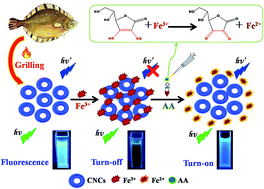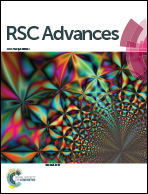A fluorescence turn-off-on chemosensor based on carbon nanocages for detection of ascorbic acid†
Abstract
A new type of carbon nanocages (CNCs) has been constructed through grilling of turbot (Scophthalmus maximus L.) by a facile method, and applied successfully as a fluorescent probe for rapid, selective as well as sensitive detection of ascorbic acid (AA). The one-step fabricated CNCs were thoroughly characterized by transmission electron microscopy (TEM), Fourier transform infrared spectroscopy (FTIR) and UV-vis spectroscopy. The CNCs showed very selective and sensitive quenching in the presence of Fe3+. The quenching efficiency of the CNCs was significantly correlated with the concentration of Fe3+ in the range 20–110 μM. The linear regression equation is y = 0.00868x − 0.0981 (R2 = 0.993) with the detection limit of the CNCs for Fe3+ at 3.96 μM. Furthermore, the fluorescence of CNCs–Fe3+ displayed a turn-on behavior upon adding AA due to the reduction of Fe3+ to Fe2+. A good linear relationship between the AA concentration and fluorescence intensity was obtained in the range of 2 to 12 μM (R2 = 0.998) with a detection limit of 97.2 nM of AA. The selectivity of the CNCs–Fe3+ for the detection of AA was explored in the presence of other possible reducing agents. Only AA induced a significant fluorescence restoration of CNCs–Fe3+, the signal being approximately 5-fold greater than with other reducing agents (uric acid, dopamine, human serum albumin, D-glucose and hemoglobin). Notably, the developed probe was successfully applied for the quantitative detection of AA in vitamin tablets with recoveries from 99.77% to 104.76%.



 Please wait while we load your content...
Please wait while we load your content...